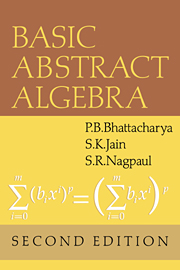Book contents
- Frontmatter
- Contents
- Preface to the second edition
- Preface to the first edition
- Glossary of symbols
- Part I Preliminaries
- Part II Groups
- Part III Rings and modules
- Chapter 9 Rings
- Chapter 10 Ideals and homomorphisms
- Chapter 11 Unique factorization domains and euclidean domains
- Chapter 12 Rings of fractions
- Chapter 13 Integers
- Chapter 14 Modules and vector spaces
- Part IV Field theory
- Part V Additional topics
- Solutions to odd-numbered problems
- Selected bibliography
- Index
Chapter 13 - Integers
Published online by Cambridge University Press: 05 June 2012
- Frontmatter
- Contents
- Preface to the second edition
- Preface to the first edition
- Glossary of symbols
- Part I Preliminaries
- Part II Groups
- Part III Rings and modules
- Chapter 9 Rings
- Chapter 10 Ideals and homomorphisms
- Chapter 11 Unique factorization domains and euclidean domains
- Chapter 12 Rings of fractions
- Chapter 13 Integers
- Chapter 14 Modules and vector spaces
- Part IV Field theory
- Part V Additional topics
- Solutions to odd-numbered problems
- Selected bibliography
- Index
Summary
In this chapter our purpose is to establish all the familiar properties of the natural numbers (= positive integers) and to obtain the ring of integers by starting from the five axioms of Peano. We also demonstrate that the five axioms are equivalent to the axioms of an ordered integral domain whose positive elements are well-ordered. Either of these sets of axioms determines a unique ring (up to isomorphism) called the ring of integers.
Peano's axioms
The traditional method of describing the set N of natural numbers axiomatically is by means of the following axioms of Peano:
(i) 1 ∈ N.
(ii) For each a ∈ N there exists a unique a′ ∈ N called the successor of a. (In other words there exists a map a ↦ a′ of N into itself, called the successor map.)
(iii) a′ ≠ 1 for any a ∈ N.
(iv) For all a,b ∈ N, a′ = b′ ⇒ a = b. (In other words, the successor map a ↦ a′ of N into itself is 1-1.)
(v) Let S be a subset of N such that (a) 1 ∈ S; (b) if a ∈ S, then a′ ∈ S. Then S = N.
The fifth axiom is called the axiom of induction or the first principle of induction and is the basis of the proofs of many theorems in mathematics.
We write 1′ = 2, 2′ = 3, 3′ = 4, and so on.
- Type
- Chapter
- Information
- Basic Abstract Algebra , pp. 233 - 245Publisher: Cambridge University PressPrint publication year: 1994



